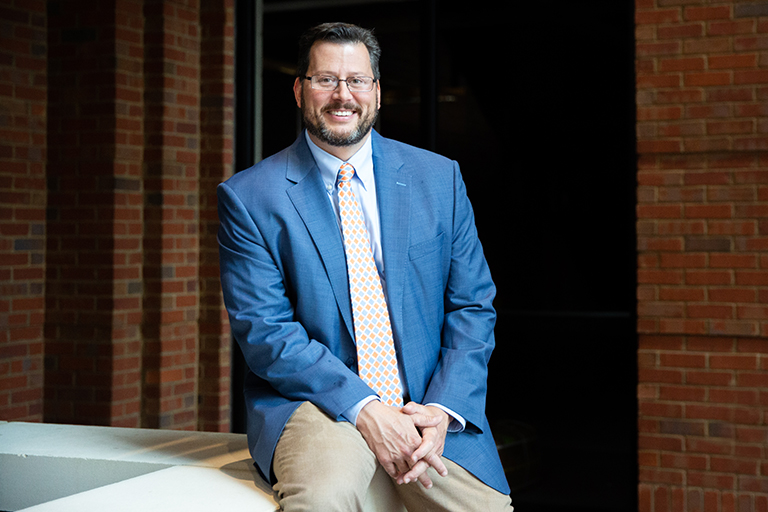College
History
Established in 1838, the Tickle College of Engineering has a long tradition of commitment to excellence in scientific research and the training of engineering professionals. The college consists of seven departments of study, seven nationally renowned research centers, and more than 100 state-of-the-art laboratories.
The college’s origins date back to the 1800s, with the first engineering classes offered in 1838. Outstanding teachers and educators, innovative researchers, and transforming innovations are all part of engineering’s amazing journey at UT.
Engineering was initially located in Reese Hall in 1888. Ten years later, classes were moved to Estabrook Hall. Over the next one hundred twenty-five years, engineering moved from literally powering to intellectually powering the university. Currently, the college spans twelve buildings and stretches from the area north of Cumberland Avenue to Neyland Drive. The newest facility, the Zeanah Engineering Complex, was dedicated in October of 2022. The growing college serves the educational and research goals of nearly four thousand students, faculty, and staff.
The college’s progress in science and technology travels from the early courses in surveying and mechanical engineering to achievements that include internationally acclaimed initiatives in renewable energy; the development of microchips that helped to create the Curiosity Mars Rover, the most innovative outer-space probe in modern history; unique revolutions in computer software; and the discovery of advanced techniques in materials engineering.
The college’s most impressive achievements, however, are the thousands of young men and women who have received their engineering education at UT and have gone on to successful futures and the unlimited contributions that they have made to their communities, the nation, and the world.
1800s
1826
UT Board of Trustees purchases “The Hill”
The UT Board of Trustees purchases “the Hill.” About the new location, the Trustees wrote, “The shape of the Hill, the commanding view from it and to it in every direction, the excellence of the water, its distance from the town, being near and yet secluded, its position between the river and main western road … together with its unquestionable healthfulness, render it a scite [sic] as eligible, almost, as the imagination can conceive.”

1834
Joseph Estabrook becomes president of East Tennessee College
Joseph Estabrook, a man of strong scientific interest and background, becomes the president of East Tennessee College. Estabrook hires a group of distinguished professors to provide instruction in chemistry, geology, mineralogy, trigonometry, and civil engineering. Surveying is offered as a subject for the first time. The student body nearly doubled during his administration, growing from 95 to 169.
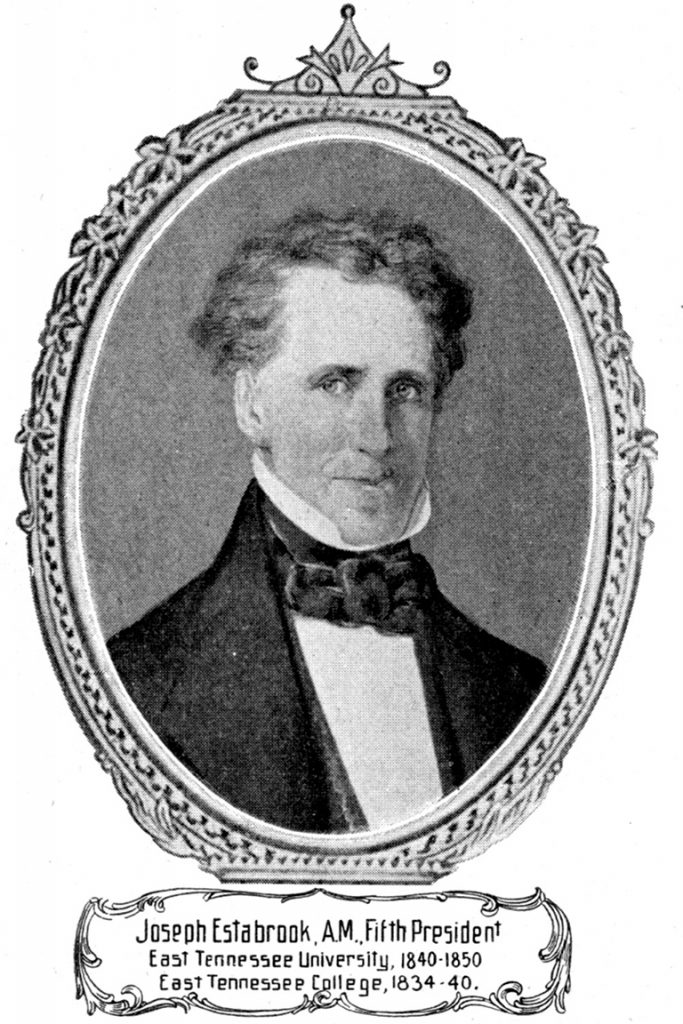
1840
East Tennessee College is renamed to East Tennessee University
President Joseph Estabrook was instrumental in persuading the state legislature to change the institution’s name from East Tennessee College to East Tennessee University. Courses in civil engineering are offered for the first time.

1869
East Tennessee University is designated as the state’s public land-grant institution
The university is designated as the state’s public land-grant institution in accordance with the Morrill Land Grant Act, signed in 1862 by President Abraham Lincoln. In addition, the East Tennessee University’s band began in 1869 as a corps of cadets. The members primarily played cornets and were often headed by a cadet leader.

1877
The university is organized into three schools
The university is organized into three schools: Agriculture and the Organic Arts; Languages and Fine Arts; and Mechanic Arts, Mining, and Engineering, which eventually is renamed the College of Engineering. Courses are offered in mechanical and mining engineering.

1879
East Tennessee University renamed to University of Tennessee
The Tennessee State Legislature officially renames East Tennessee University as the University of Tennessee under President Thomas Humes and authorizes the granting of advanced degrees in both civil and mining engineering.
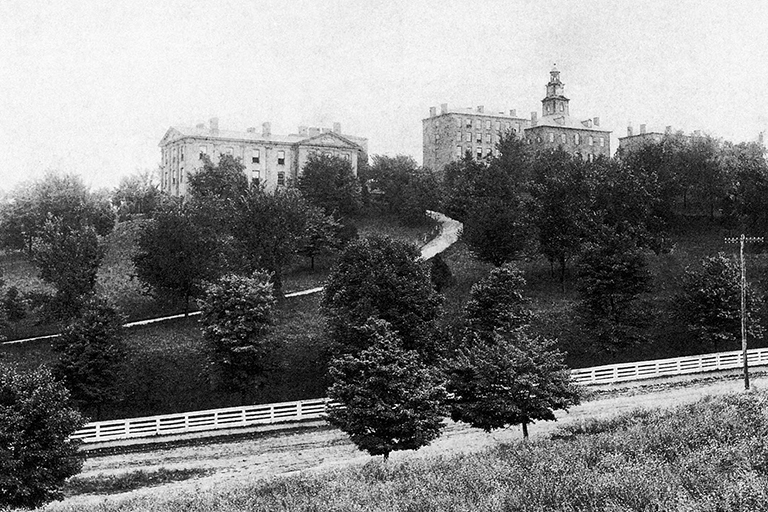
1880
Four-year bachelor’s degree are offered
Four-year bachelor’s degrees are offered in civil, mechanical, and mining engineering. The designation as a land-grant institution in 1869 required the university to offer courses in military science. For a short time, the university instituted compulsory military training and uniforms for all students.

1895
Electrical Engineering program is established
The electrical engineering program is established. In the beginning, Charles Perkins, an associate professor of physics and electrical engineering, was the only faculty member teaching a handful of students. In 1907, electrical engineering became its own department, and currently the Department of Electrical Engineering and Computer Science is the largest department in the college.

1898
First mechanical engineering department head was appointed
Estabrook Hall is constructed initially to house the departments of Mechanical Engineering and Mechanic Arts. The building made room for a new power plant in addition to experimental labs. The first mechanical engineering department head, Theodore F. Burgdorf, was appointed.
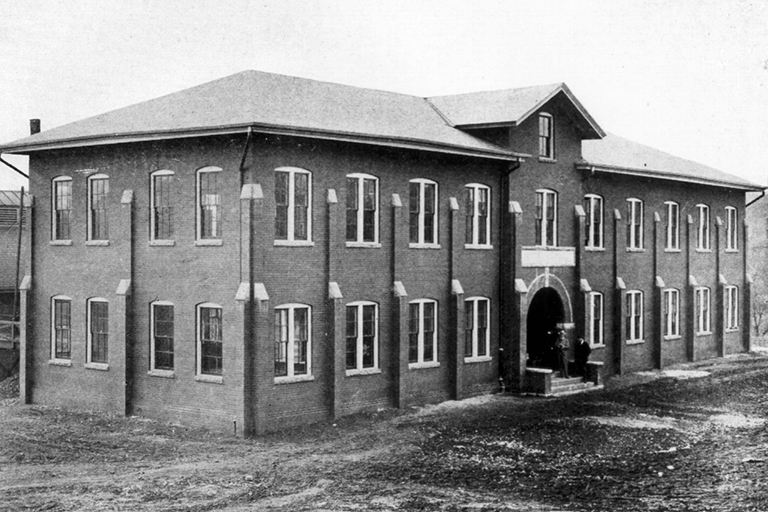
1900s
1905
College of Engineering
The engineering academic unit is renamed the College of Engineering, with Professor Charles A. Perkins as chairman of the faculty. Perkins taught at UT for more than 50 years, until he was well over 80 years old. He was the author of a widely used textbook in electrical engineering. His wife, Angie Warren Perkins was UT’s first dean of women.

1907
Charles Edward Ferris: 1907-1940
During Professor Charles Ferris’s tenure as the first dean of engineering, the Department of Chemical Engineering was established, and Dean Ferris gained national prominence by funding one of the country’s first cooperative engineering programs. Following his retirement from the deanship, Professor Ferris remained at the university and founded the Department of Industrial Engineering. He completed fifty years of service to UT.

1912
First Engineers Day
The college holds its first Engineers Day. The event was initially established for students to help clean up the campus. Today, it serves as a fun day of competitions, demonstrations, and workshops for more than 1,900 students from nearly 70 different high schools. Participants experience an overview of the different engineering disciplines and see examples of how an engineer’s work impacts daily life.

1926
Cooperative Engineering Program established
The Cooperative Engineering Program (now the Engineering Professional Practice Program) is established in the College of Engineering. The program offers students an opportunity to combine both academic study and professional work experience by securing paid co-op or internship positions with an employer. The program is the second oldest in the south.

1930
Ferris Hall is built
Ferris Hall is built, named after Charles E. Ferris, the first dean of the College of Engineering and founder of the TCE’s Cooperative Engineering Program. The building formerly housed the Min H. Kao Department of Electrical Engineering and Computer Science. The Department of Materials Science and Engineering relocated to Ferris in 2012.

1936
Department of Chemical Engineering is established
The Department of Chemical Engineering is established. It received accreditation from AIChE in 1939, making it one of the first four chemical engineering programs in the South to receive accreditation. Today, its faculty are actively leading research into both traditional chemical and energy industries as well as new areas of application and innovation, such as biotechnology, pharmaceuticals, advanced materials, and sustainable energy.

1940
Nathan Washington Dougherty: 1940-1956
A man of many interests and talents, Dean Dougherty was well known for his service to the field of athletics, both at the university and in the Southeast. Dean Dougherty served as president of the old Southern Conference. He also helped organize the present Southeastern Conference and served as its first secretary-treasurer. During his sixteen-year administration as dean, the college experienced phenomenal growth in numbers of students and faculty, physical facilities, scope of course offerings, and external research activities. The Nathan W. Dougherty Engineering Building was dedicated in Dean Dougherty’s honor on June 6, 1964.

1948
Department of Industrial Engineering is established
The Department of Industrial Engineering is established, thanks in part to Charles Ferris. The department is now located in the John D. Tickle Engineering Building. The college and the building are named after the John D. Tickle, an ISE alumnus.

1949
Perkins Hall is constructed
Perkins Hall is constructed, named after Charles A. Perkins, chair of the engineering department before it was established as a separate college in 1877. The 80,805-square-foot building, designed by Barber and McMurry and built by the V. L. Nicholson Company, was dedicated on March 6, 1950, in a formal ceremony in Alumni Memorial Building, followed by tours of both Perkins and Ferris Halls.

1951
Board of Trustees authorizes the granting of PhD degrees
The university’s Board of Trustees authorizes the granting of PhD degrees with majors in chemical engineering and in metallurgy—the first engineering doctoral degrees in Tennessee. The first chemical engineering PhD graduate, Frank Chance, spent his professional career with Pfizer. This is also the year the Vols football team won its fourth national championship, and the second of back-to-back championships, under “the General” head coach Robert Neyland.

1956
Armor T. Granger: 1956-1965
Dean Granger’s contributions to the university, the community, and the engineering profession were numerous. His two greatest loves–students and teaching–became his most memorable legacies. The Armor T. Granger Professorship was established in his honor. The professorship is currently held by Bamin Khomami.

1957
Doctoral program in metallurgy is added
A doctoral program in metallurgy is added to support the growing involvement with the university in cooperative projects with the Oak Ridge National Laboratory and the US Air Force’s Arnold Engineering Development Center (AEDC) in Tullahoma, Tennessee. The following year, B. H. Goethert proposed to the air force and the State of Tennessee that a Tennessee Aerospace Institute, which eventually became UT Space Institute (UTSI), be located near AEDC. Goethert became UTSI’s first director.

1957
Department of Nuclear Engineering is established
The Department of Nuclear Engineering is established, becoming the first Department of Nuclear Engineering in the United States. Pietro Pasqua served as its first department head until his retirement in 1987. Its graduate program is consistently ranked as one of the top in the nation by U.S. News and World Report.

1963
Dougherty Engineering Building is constructed
The Dougherty Engineering Building is constructed, named for Nathan Dougherty, who served as dean of the college from 1940 to 1956. When built, the facility housed chemical, mechanical, aerospace, and nuclear engineering. The 123,000-square-foot structure is larger than Ayres Hall and Ferris Hall combined. It was completely air-conditioned when built, and its electrical load exceeded that of all other campus buildings on the Hill.

1964
UT Space Institute is established
The UT Space Institute is established from the resident graduate programs at the Air Force’s Arnold Engineering Development Center in Tullahoma, Tennessee. UTSI began offering graduate coursework in aerospace engineering as a branch of the College of Engineering. The institute originally held its classes and had its offices in the Arnold Center. In November 1965, it moved to a new $1 million building constructed with funds appropriated by the legislature and located on 365 acres declared surplus by the Air Force. The property was formally transferred to UT by the Tennessee Department of Health, Education, and Welfare on January 29, 1964.

1965
Charles H. Weaver: 1965-1968
Weaver made many significant contributions to the college. One of his primary goals was to link the mission of the college to the needs of industry. Student enrollments and research activities escalated under Dean Weaver’s guidance. He became UT’s first chancellor and was charged with the responsibility for all teaching, research, and public service programs on the Knoxville campus. After stepping down as chancellor in 1971, he became dean of the UT Space Institute.

1968
Fred N. Peebles: 1968-1980
Under Peebles’s assertive leadership, the College of Engineering experienced phenomenal growth in size and quality of its academic and research programs. Dean Peebles was also the first dean to initiate a process for faculty performance review. He was instrumental in establishing the college’s Minority Engineering Scholarship Program, which eventually became the Office of Engineering Diversity Programs.

1973
College establishes the Minority Engineering Scholarship Program
The college establishes the Minority Engineering Scholarship Program in cooperation with industry to increase the number of underrepresented students enrolled in engineering studies. Fred D. Brown Jr. served as the first director. The program is later incorporated as the basis for the college’s Office of Engineering Diversity Programs, which works to enable the successful recruitment, retention, and graduation of underrepresented students.

1973
Department of Nuclear Engineering
The university’s power plant, built in 1925, is renovated to house the Department of Nuclear Engineering. In 1988, the building is named Pasqua Hall in honor of Dr. Pietro F. Pasqua, the first head of the Department of Nuclear Engineering. In July 2018, Pasqua Hall was demolished to make way for the Zeanah Engineering Complex, the current home for the department.

1973
John Prados served as interim UT chancellor
Longtime engineering professor and administrator John Prados served as interim UT chancellor in 1973, a brief stint in his 60-year university career. Prados spent time as an engineering professor, associate dean of engineering, dean of admissions and records, and even acting chancellor at UT Martin. He was also an acting director at the UT Space Institute and the UT System vice president for academic affairs. In 2016, Prados was named the inaugural member of UT’s Department of Chemical and Biomolecular Engineering Hall of Fame.

1973
Aerospace engineering established
Aerospace engineering is officially indoctrinated into the mechanical engineering department. Today, the Department of Mechanical, Aerospace, and Biomedical Engineering is one of the largest in the college and includes the UT Space Institute in Tullahoma, Tennessee. Thirteen MABE faculty members are located at UTSI where they are performing internationally recognized research in engineering, hypersonics, and aviation systems. Nine astronauts are UTSI alumni.

1981
Robert E.C. Weaver: 1981-1983
Dean Weaver believed that Tennessee should be a leadership state for the nation by serving as a magnet for industry. He believed that UT engineering graduates had the opportunity to significantly influence the corporate world.

1983
William T. Snyder: 1983-1992
During Snyder’s tenure as dean, he sought radical change through a different style of management. He had a long-term vision for alumni support and industry involvement in the college. His ambitious agenda included the creation of several private Chairs of Excellence, which dramatically increased interdisciplinary research; an aggressive recruitment program for academically superior students; and a $12 million capital campaign. In July 1992, Dean Snyder was named UT Chancellor, and served in that role through June 30, 2001.
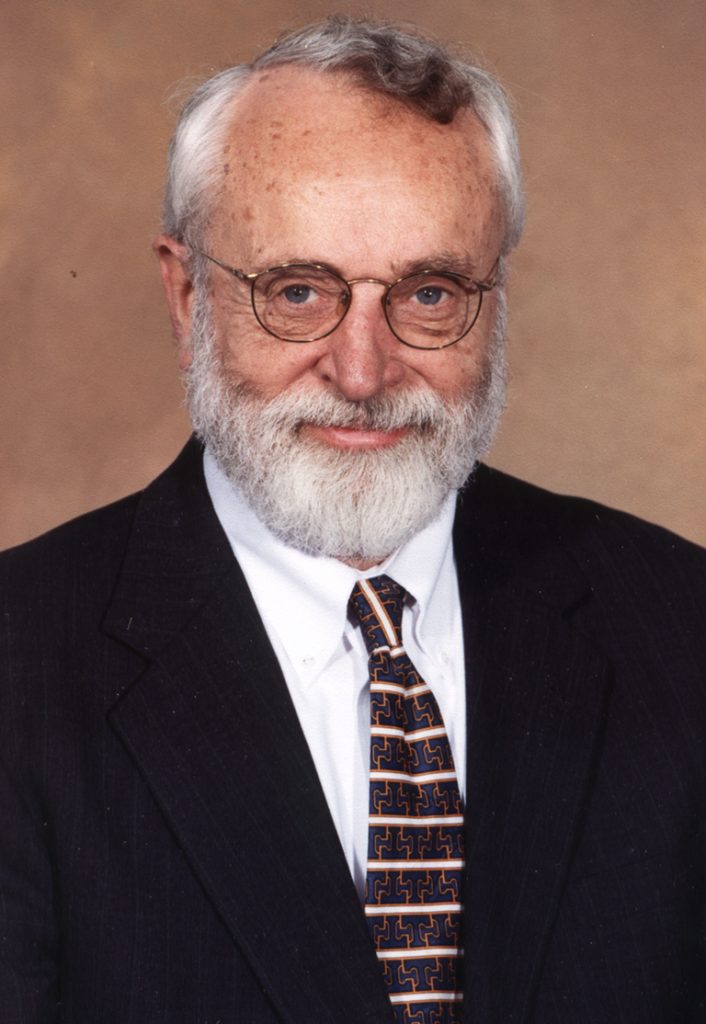
1992
Jerry E. Stoneking: 1992-2001
Stoneking was a dedicated academician and engineer who believed that students perform better when excited about their work. Under his guidance, the college reorganized its first-year curriculum into the innovative engage program. Dean Stoneking promoted and expanded the college’s funded research, strengthened and increased industry partnerships, organized a $33 million development campaign and formed two new degree programs in biomedical and computer engineering.

1997
Jerry E. Stoneking engage™ Engineering Fundamentals Program established
The college established the Jerry E. Stoneking engage™ Engineering Fundamentals Program for first-year students through a major grant from the National Science Foundation. The program is one of the most innovative of its kind in the nation. It takes a leading-edge, success-oriented approach to freshman engineering education, placing problem solving through collaboration as a priority.

1997
Science and Engineering Research Facility (SERF) is constructed
The Science and Engineering Research Facility (SERF) is constructed, a $25 million, 120,000 square-foot building that houses laboratories and classrooms for both the Tickle College of Engineering and the College of Arts and Sciences. The building sits on the site of the former Science Hall, razed in 1967. SERF connects the Earth and Planetary Sciences Building and Dabney/Buehler Hall.

2000s
2000
UT joins with Battelle
UT joins with Battelle to take over management of Oak Ridge National Laboratory (ORNL). ORNL provides exceptional researchers with distinctive equipment and unique facilities to solve some of the world’s most challenging scientific and technical problems. Its resources include the Spallation Neutron Source, the world’s most powerful source of pulsed neutrons for research; the world’s fastest unclassified supercomputer; one of the world’s leading research reactors; and some of the largest and most advanced additive manufacturing equipment in the world.

2003
Way Kuo: 2003-2008
Dean Kuo came to the University of Tennessee from Texas A&M University. Under his guidance, the college greatly expanded its research role through partnerships and joint professorships with Oak Ridge National Laboratory and other public, government, and private entities. Enrollment in the PhD program also increased dramatically during this time.

2005
Min Kao donates transformational gift
Min Kao, electrical engineering alumnus and CEO of Garmin Ltd., commits to a transformational gift of $17.5 million to the college, with $12.5 million designated to construct a new, state-of-the-art building to house the Min H. Kao Department of Electrical Engineering and Computer Science. The state provided $25 million. Kao said, “I am fortunate to be in a position to give back to a university that gave so much to me.”

2006
Scintillation Materials Research Center established
In partnership with Siemens Medical Solutions Medical Imaging, the college establishes the Scintillation Materials Research Center. The center specializes in growth and characterization of scintillation materials, which are used in a diversity of applications. In addition, the Governor’s Chair Program was established by UT and Oak Ridge National Laboratory, bringing exceptionally accomplished researchers from around the world to Tennessee. The college currently has 11 Governor’s Chairs across several departments.

2007
Min H. Kao Electrical Engineering and Computer Science Building
The college breaks ground on the new Min H. Kao Electrical Engineering and Computer Science Building on May 14, 2007, named after Min Kao, electrical engineering alumnus and CEO of Garmin Ltd. Kao and his wife, Yu-Fan, have generously supported engineering and science education over the years and, after discussing with his former mentor and UT electrical engineering professor, James C. Hung, the Kaos elected to donate $12.5 million to construct a new building for the college.
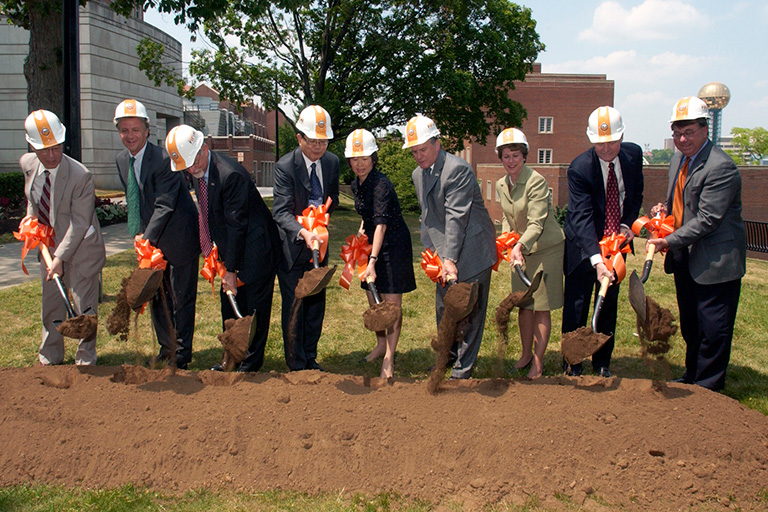
2008
Wayne T. Davis: 2008 – 2018
Dean Davis’s thirty-year career at the University of Tennessee culminated in his appointment as dean of engineering following serving as Interim Dean and as Associate Dean for Research and Technology for the college. Under Dean Davis’s leadership, the college has surmounted fiscal challenges and has seen increased enrollment in both undergraduate and graduate programs.

2010
John D. Tickle Engineering Building
The college breaks ground on the John D. Tickle Engineering Building. The new facility houses the Department of Civil and Environmental Engineering and the Department of Industrial and Systems Engineering. It is named after alumnus John Tickle, president and owner of the Strongwell Corporation.

2012
Min H. Kao Electrical Engineering and Computer Science Building dedicated
The college dedicates the Min H. Kao Electrical Engineering and Computer Science Building in a gala event on March 14 with a ceremony that included Kao and his wife, Fan; Governor Bill Haslam; UT President Joseph DiPietro; UT Chancellor Jimmy G. Cheek; Dean Wayne T. Davis; EECS Professor and Department Head Kevin Tomsovic; Sue Hung, wife of the late EECS professor James Hung, Kao’s academic mentor; and Min H. Kao Fellow Michael Pickelsimer.

2013
175 years of engineering at the University of Tennessee
The college celebrates 175 years of engineering at the University of Tennessee. The establishment of the Wayne T. Davis Endowed Dean’s Chair of Engineering was announced at the gala event recognizing the college’s 175th anniversary. Celeste Baine, a biomedical engineer, director of the Engineering Education Service Center, and the award-winning author of over twenty books on engineering careers and education, spoke at the gala.
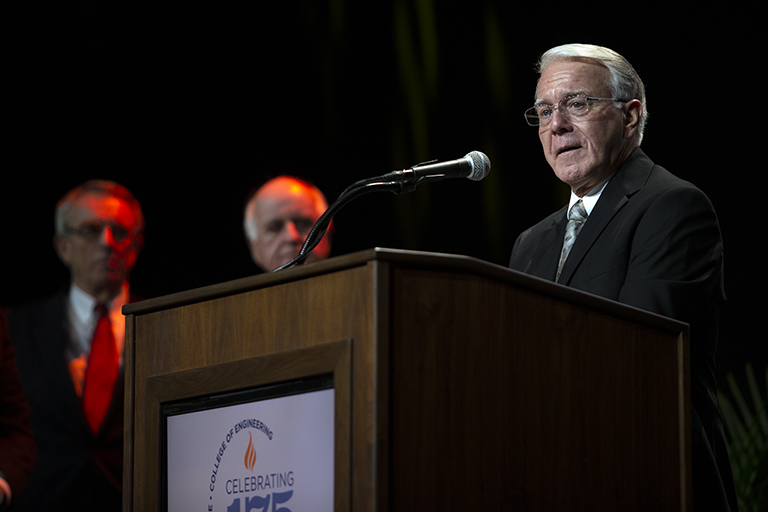
2013
John D. Tickle Engineering Building is dedicated
The John D. Tickle Engineering Building is dedicated on October 4, 2013. Unique to this building and to the Knoxville campus is a pedestrian bridge donated by Strongwell Corporation and manufactured from the company’s pultruded fiber reinforced polymer structural components. Enhancing pedestrian access, this bridge is a signature element that provides both a visual and physical connection from the building to the center of the engineering campus on the Hill.

2015
UTSI celebrates 50 years
The University of Tennessee Space Institute (UTSI) in Tullahoma, Tennessee, celebrates its 50th anniversary. UTSI is an internationally recognized institution for graduate study and research in engineering, physics, mathematics, and aviation systems and has made remarkable contributions at the local, state, national, and global levels, and its alumni includes nine astronauts.

2015
College hosts the first WomEngineers Day
The college hosts the first WomEngineers Day, a biennial conference that brings together student, faculty, staff, and industry professionals to discuss topics that are not covered in the STEM curriculum but are important for navigating career and life choices. The first event was organized primarily by 19 UT students with the support of the college’s Board of Advisors. It was held at the Knoxville Convention Center with more than 350 high school and college students in attendance.

2016
Institute for Advanced Composites Manufacturing Innovation
President Barack Obama announces UT’s leadership of the $259 million Institute for Advanced Composites Manufacturing Innovation, of which the college’s faculty and researchers play a major role. IACMI’s collaborative structure allows private industry to work with research institutions and state partners to accelerate the development and adoption of cutting-edge manufacturing technologies.

2016
Tickle College of Engineering named after donor and alumnus
For just the second time in the 222-year history of UT, an academic college has been named in recognition of an alumnus and donor. On October 14, 2016, the university’s Board of Trustees voted to name our college the Tickle College of Engineering in recognition of the latest transformational support from the longtime benefactor.

2016
The Joint Institute for Advanced Materials (JIAM)
The Joint Institute for Advanced Materials (JIAM) opens on the university’s Cherokee Farm Research Campus. JIAM is composed of a multidisciplinary team of scientists from UT and Oak Ridge National Laboratory and is one of the world’s largest and best-equipped centers for advanced materials science. Its research is focused on three broad classes of materials: Advanced Structural Materials, Soft and Hybrid Materials, and Functional Materials and Devices.

2017
Joseph C. and Judith E. Cook Grand Challenge Honors Program
The engineering honors program is renamed the Joseph C. and Judith E. Cook Grand Challenge Honors Program following a significant commitment by industrial engineering alumnus Joe Cook, who graduated as an industrial engineering major and a Torchbearer in 1965, and his wife, Judy. The 14 Grand Challenges of Engineering are global issues identified by the National Academy of Engineering.

2018
Dean Wayne Davis is announced Interim Chancellor of UT Knoxville
Dean Wayne Davis is announced Interim Chancellor of the University of Tennessee, Knoxville. The college’s Associate Dean for Faculty Affairs and Engagement Lynne Parker is announced as interim dean. In August, Parker began serving as assistant director for artificial intelligence for the White House Office of Science and Technology Policy. In her place, John Fisher Distinguished Professor Mark Dean stepped up to serve in the interim dean position.

2018
College broke ground on the Zeanah Engineering Complex
The college broke ground on the 228-000 square-foot Zeanah Engineering Complex, which opened in 2021 and serves as the Gateway to Engineering. The building is home to the Department of Nuclear Engineering, the Min H. and Yu Fan Kao Innovation and Collaboration Studio, the innovative Jerry E. Stoneking engage Engineering Fundamentals program, the Joseph C. and Judith E. Cook Grand Challenge Honors program, and college administrative offices.

2019
Janis Terpenny: 2018 – 2020
Janis Terpenny joins the college as dean and Wayne T. Davis Dean’s Chair. Prior to coming to UT, she was head of the industrial and manufacturing engineering department at Pennsylvania State University. Community, culture, partnerships, and development were priorities for Dean Terpenny. She led the college through the beginning of the COVID-19 pandemic, the development of a new strategic plan, closer partnerships with key constituencies, and the development of an extensive diversity action plan. She was also successful in many fundraising activities for the college.

2020
Name approved for the Zeanah Engineering Complex
On September 11, the UT Board of Trustees voted to approve the naming of the Zeanah Engineering Complex after longtime supporters Eric (’84) and Elaine (’82) Zeanah. The complex, dubbed the Gateway to Engineering, opened to students at the start of the fall 2021 semester.

2021
Matthew Mench: 2020 – current
Janis Terpenny steps down as dean; Matthew Mench, head of the Department of Mechanical, Aerospace, and Biomedical Engineering (MABE), steps up to serve as interim dean. In June, after a nationwide search, Mench was named dean and Wayne T. Davis Dean’s Chair. Mench had served as department head of MABE since August 2013, except for a brief period in 2019 and 2020 when he stepped up to serve as interim vice chancellor for research.
